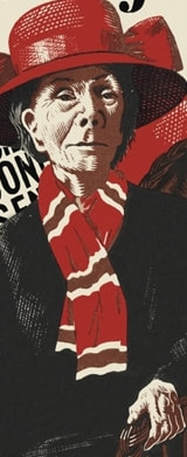I have decided to divide this initial discussion into two posts instead of one. I will happily continue the conversation with a Friday blog post incorporating the topics of social attitudes, psychology, and concluding thoughts about the first chapters of the book! If you wish to add to the discussion on any of the ideas here, please use the comment tool below.
Nick writes: "We're going to take a butcher's at Gladys Mitchell's second novel. For those of you who don't speak fluent Cockney, a butcher's = to look at (intransitive verb), from butcher's hook. And speaking of which, what's this dangling from one?"
To summarize, the plot through Chapter Six is busy, satirical, and makes me think tonally of a French farce crossed with a cheeky parody of the English village murder mystery. We learn about the disappearance of Rupert Sethleigh, an unlikable man who had quarreled with Jim Redsey, now the prime suspect. Indeed, the author wants us to wonder about the hapless young man; he tells a visiting solicitor that Sethleigh has departed for America and is caught digging a suspicious hole by the Stone of Sacrifice in the woods.
Matronly Mrs. Bryce Harringay is put out by all the strange incidents, but that appears to be her usual state. Aubrey Harringay, an energetic and precocious lad of fifteen, and the vicar's daughter, Felicity Broome, are soon caught up in the affair. Events take a sensational turn when human joints are discovered displayed in a butcher's shop window.
ON MRS. BRADLEY
 Mrs. Bradley, from the dustjacket of Brazen Tongue (1940).
Mrs. Bradley, from the dustjacket of Brazen Tongue (1940). Joyka observes that Mitchell's description of her detective (it was only her second appearance, after all) was "as I remembered with one major exception. The Chapter One line, 'age no longer interesting except to the more grasping and avaricious of her relatives': if this implication of avaricious relatives waiting for her to die occurs elsewhere, I don't remember it." Nor do I; the relations we meet in future stories don't have a single greedy nephew or niece to be found. That is likely connected with the character that Mrs. Bradley becomes as shaped by the author, which is not a woman known for her wealth but rather for her strength (mental and physical), her professional success, and her command for the situation. To highlight wealth would be, to me, to muddle or mute the idea of Mrs. Bradley's independent personality.
"Twice widowed, black-eyed, claw-fingered…she smiled the saurian smile of the sand lizard and basked in the full glare of the sun in the charming old-world garden of the Stone House, Wandles."
ON YOUTH
Indeed, it's clear that Gladys Mitchell (a lifelong educator at girls' schools) has an "affinity for young people" in this book and in others, as Jennifer Clement points out, especially as her sleuth is "quite elderly, although physically strong." Margaret Plichta adds that Mrs. Bradley goes further and bonds with the youthful Aubrey and Felicity, taking them into her confidence.
Margaret continues: "One thing that has always stood out to me is that children in some of her books seem to skew older than their ages, and I find that here with Aubrey. I thought this to be true as well in The Rising of the Moon with the two brothers…but in Come Away, Death, the boys seem to be typical for their age. Comparing these young people with contemporary kids shows a stark difference in the sophistication of Aubrey and Felicity's thinking."
J.F. Norris over at Pretty Sinister Books shares his impressions: "The opening chapters are rife with wry wit and obvious satirical touches. The chapter titles alone tell us we’re in for a raucous fifty-plus pages. The humor works best when Mitchell is in farce mode. I’m not so keen on her class prejudice and superiority. [The chapter titles] 'Farcical Proceedings during an Afternoon in June' and 'Midsummer Madness' are signals to any reader that this mystery novel is not to be taken too seriously. Mitchell seems to like her characters, but clearly isn’t going to play favorites with anyone. Everyone’s faults are fair game for her trenchant humor and merciless attacks."
From Martyn Hobbs, who has the wonderful distinction of living in Gladys Mitchell's birthplace home (!):
"I love the wit and theatricality of these first six chapters: GM introduces her dramatis personae in bright, brisk consecutive paragraphs; the opening scenes recall a drawing-room comedy; there are allusions to theatre and performance, entrances and exits; there are even cucumber sandwiches, while Mary Kate, the maid, is pure stage Oirish… The concise descriptions of her characters are also like a dramatist's notes – efficient, precise, witty. The whole narrative suggests a fabrication, a confection, carefully directed by the author."
And with this, Martyn identifies a reason why Gladys Mitchell's writing is so special to me: especially in her books of the first two decades, there is a wonderful sense of experimentation and conscious style. The fact that tone and style are malleable and subject to the author's curiosity is wonderful, as it makes her many mysteries feel like unique, different experiences. With Butcher's Shop, GM has great fun with theatricality and the concept of farce – the episodic early scenes and the well-timed activities and misunderstandings in the woods are fine examples – but other titles tackle other moods and methods. The Saltmarsh Murders comes even closer to Wodehousian comedy (an influence mentioned by Kate, Nick, and Martyn); When Last I Died feels to me like an ode to Wilkie Collins, with a ghost story told through artifacts; The Rising of the Moon is loving nostalgia and a celebration of the innocence of youth; while the curious wartime mystery Sunset over Soho feels hallucinatory and haunted.
The next call for group reading comments is Monday, November 12 on Chapters Seven through Twelve; please email me your stray thoughts care of [email protected] .
 RSS Feed
RSS Feed